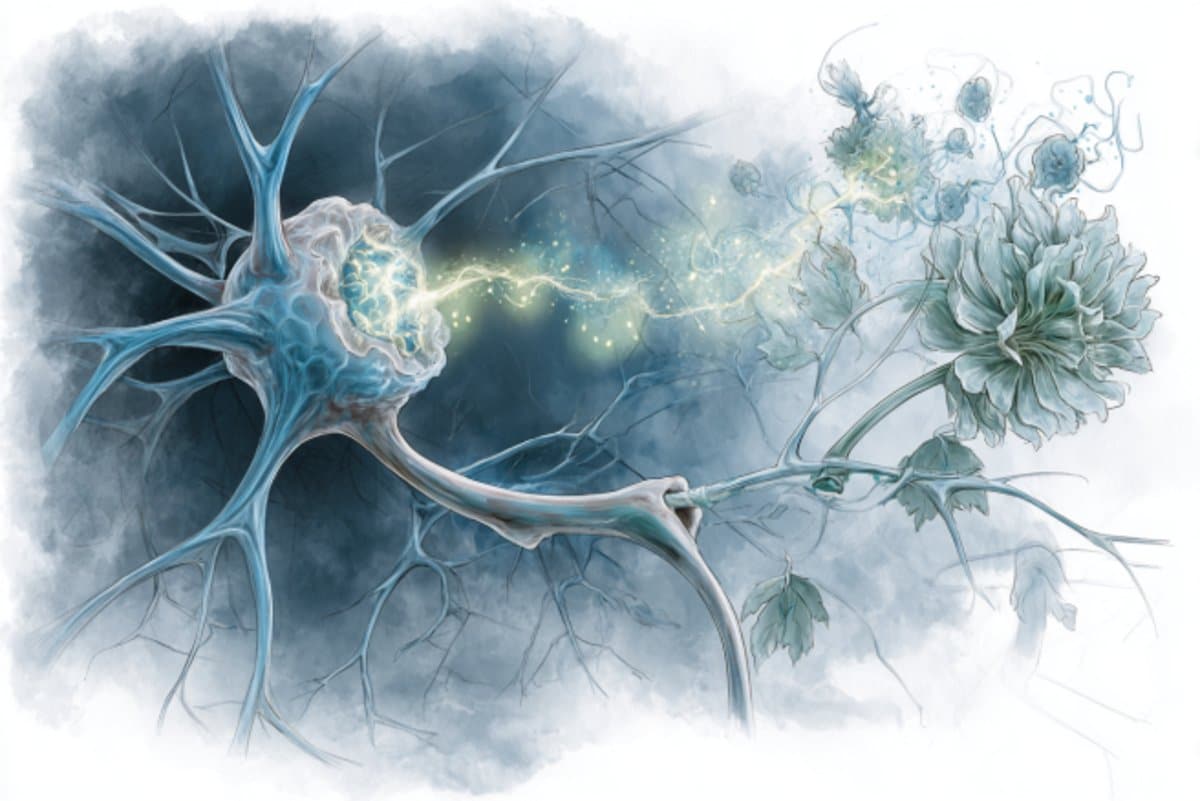Summary: A fading sense of smell may be one of the earliest warning signs of Alzheimer’s disease, and new research reveals why. Scientists found that microglia, immune cells in the brain, mistakenly remove nerve fibers connecting the locus coeruleus and olfactory bulb—two regions essential for processing odors.
This immune-driven pruning occurs when hyperactive neurons display altered membranes, marking them as defective even when they are not. By identifying this mechanism, the study highlights a pathway that could allow for earlier diagnosis and treatment before cognitive symptoms begin.
Key Facts
- Immune Misfire: Microglia break down nerve fibers linking the locus coeruleus and olfactory bulb.
- Early Signal: These changes occur before cognitive decline, making smell loss a potential diagnostic tool.
- Therapeutic Window: Findings may allow earlier use of amyloid-beta antibody treatments.
Source: DZNE
A fading sense of smell can be one of the earliest signs of Alzheimer’s disease even before cognitive impairments manifest. Research by scientists at DZNE and Ludwig-Maximilians-Universität München (LMU) sheds new light on this phenomenon, pointing to a significant role for the brain’s immune response, which seems to fatally attack neuronal fibers crucial for the perception of odors.
The study, published in the journal Nature Communications, is based on observations in mice and humans, including analysis of brain tissue and so-called PET scanning. These findings may help to devise ways for early diagnosis and, consequently, early treatment.
The researchers come to the conclusion that these olfactory dysfunctions arise because immune cells of the brain called “microglia” remove connections between two brain regions, namely the olfactory bulb and the locus coeruleus.
The olfactory bulb, located in the forebrain, analyzes sensory information from the nose’s scent receptors. The locus coeruleus, a region of the brainstem, influences this processing by means of long nerve fibers originating from neurons in the locus coeruleus and extending all the way to the olfactory bulb.
“The locus coeruleus regulates a variety physiological mechanisms. These include, for example, cerebral blood flow, sleep-wake cycles, and sensory processing. The latter applies, in particular, also to the sense of smell,” says Dr. Lars Paeger, a scientist at DZNE and LMU.
“Our study suggests that in early Alzheimer’s disease, changes occur in the nerve fibers linking the locus coeruleus to the olfactory bulb. These alterations signal to the microglia that affected fibers are defective or superfluous. Consequently, the microglia break them down.”
Alterations in the membrane
Specifically, the team of Dr. Lars Paeger and Prof. Dr. Jochen Herms, who is a co-author of the current publication, found evidence of changes in the composition of the membranes of the affected nerve fibers: Phosphatidylserine, a fatty acid that usually occurs inside a neuron’s membrane, had been moved to the outside.
“Presence of phosphatidylserine at the outer site of the cell membrane is known to be an “eat-me” signal for microglia. In the olfactory bulb, this is usually associated with a process called synaptic pruning, which serves to remove unnecessary or dysfunctional neuronal connections”, explains Paeger.
“In our situation, we assume that the shift in membrane composition is triggered by hyperactivity of the affected neurons due to Alzheimer’s disease. That is, these neurons exhibit abnormal firing.”
A wide range of data
The findings of Paeger and colleagues are based on a plethora of observations. These include studies on mice with features of Alzheimer’s disease, analysis of brain samples from deceased Alzheimer’s patients, and positron emission tomography (PET) scans of the brains of individuals with Alzheimer’s or mild cognitive impairment.
“Smell issues in Alzheimer’s disease and damage to the associated nerves have been discussed for some time. However, the causes were unclear until yet.
“Now, our findings point to an immunological mechanism as cause for such dysfunctions – and, in particular, that such events already arise in the early stages of Alzheimer’s disease,” says Joachim Herms, a research group leader at DZNE and LMU as well as a member of the Munich-based “SyNergy” Cluster of Excellence.
Perspectives for early diagnosis
So-called amyloid-beta antibodies have recently become available for the treatment of Alzheimer’s. For this novel therapy to be effective, it needs to be applied at an early stage of the disease, and this is precisely where the current research could be significant.
“Our findings could pave the way for the early identification of patients at risk of developing Alzheimer’s, enabling them to undergo comprehensive testing to confirm the diagnosis before cognitive problems arise. This would allow earlier intervention with amyloid-beta antibodies, increasing the probability of a positive response,” says Herms.
About this olfaction and Alzheimer’s disease research news
Author: Marcus Neitzert
Source: DZNE
Contact: Marcus Neitzert – DZNE
Image: The image is credited to Neuroscience News
Original Research: Open access.
“Early Locus Coeruleus noradrenergic axon loss drives olfactory dysfunction in Alzheimer’s disease” by Lars Paeger et al. Nature Communications
Abstract
Early Locus Coeruleus noradrenergic axon loss drives olfactory dysfunction in Alzheimer’s disease
Alzheimer’s disease (AD) often begins with non-cognitive symptoms such as olfactory deficits, which can predict later cognitive decline, though the mechanisms remain unclear.
Pathologically, the brainstem locus coeruleus (LC), the main source of the neurotransmitter noradrenalin (NA) modulating olfactory information processing is affected early.
Here we show early and distinct loss of noradrenergic input to the olfactory bulb (OB) coinciding with impaired olfaction in an AD mouse model, before appearance of amyloid plaques.
Mechanistically, OB microglia recognize and phagocytose LC axons. Reducing phagocytosis genetically preserves LC axons and olfaction.
Prodromal AD patients display elevated TSPO-PET signals in the OB, similarly to AppNL-G-F mice. We further confirm early LC axon degeneration in post-mortem OBs in patients with early AD.
Our findings reveal a mechanism linking early LC damage to hyposmia in AD, suggesting olfactory testing and neurocircuit imaging for early diagnosis and enable timely therapeutic intervention for Alzheimer’s disease.







